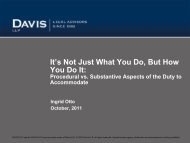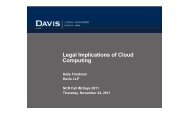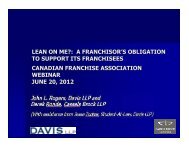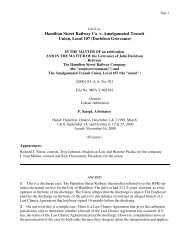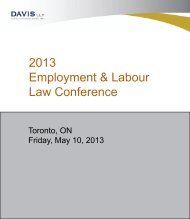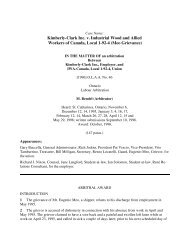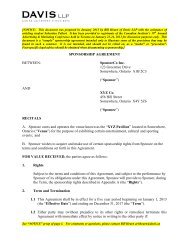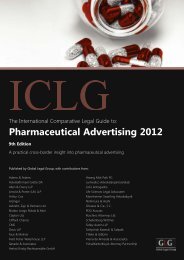Download PDF - 202 kb - Davis LLP
Download PDF - 202 kb - Davis LLP
Download PDF - 202 kb - Davis LLP
You also want an ePaper? Increase the reach of your titles
YUMPU automatically turns print PDFs into web optimized ePapers that Google loves.
CREATIVITYNACMOctober 20, 2011Hubert SibreDAVIS <strong>LLP</strong> and the DAVIS <strong>LLP</strong> logo are trade-marks of <strong>Davis</strong> <strong>LLP</strong>, © 2007 <strong>Davis</strong> <strong>LLP</strong>, all rights reserved. Unauthorized copying, distribution and transmission is strictly prohibited.
“It’s exhausting to think and create, that’s whywe rarely do it”Henry Ford
The paradox• We learn rules• We are told that foreseeable outcomes arepositive• We rely on others’ opinions to build our own
“Life is a mix of routine and creativity”Abraham Maslow
What is creativity?
“A series of actions operating original and significanttransformation within our consciousness”Ghiselin
CreativityMental process which allows for the discovery ofnew ideas and concepts along with relationshipsbetween existing ideas and concepts through theconscious and subconscious processes
“Creativity is a process extended in timeand characterized by its originality,reality transformation and conscious result”Mackinnon
CreativityTo be creative, a new idea or concept must be, poriginal, appropriate and, most importantly, usefulto reach the intended goal
“Creation is not the result of imagination but thetransformation of contemplation into something useful”Descartes
Creativity is the new “buzzword”
Criteria for recognizing creativity• New• Useful• Motivated• Valued• Transformative and revolutionary• Clarified• Passionate• Visionary• Intuitive
“To create is to provoke the extraordinary meetingbetween two pre-existing elements which were inseparate universes”Arthur Koestler
CreativityFor Hindus, Taoists, Buddhists, Confucians:There is no concept of creation from nothingCreativity is the capacity to recognize for the first timeCreativity is the capacity to recognize for the first timesomething that already exists
“The level of thinking that got you to where you noware will not get you to where you dream of being”Albert Einstein
We have to recognize change as positive
“Who moved my cheese?”Spencer Johnson
Change• Must accept it before it happens• Sometimes it happens for no reason• It is an opportunity to improve• In life neutral does not exist
Characteristics of difficult situations• Obscure: absence of goal or clarity• Complexity: a great amount of what appears to beunrelated elements• Resources: limits of time and resources
“The most important and most difficult task is notto get the right answer but to find the right question”Peter Drucker
Questions• Why?• Why not?• What would happen if?• Imagine if?
Innovation• Innovation starts with creativity• Innovation: is the ability to transform a creativeidea into a viable, acceptable and commerciallyviable form
Creativity processSome suggestions…
Creativity can be found• A divine intervention• An intense conscious process• A social environment in which one evolves• Particular personality traits• Serendipity• Subconscious• And so much more…
Stages of thinking• Graham Wallas’ The Art of Thought (1926)• Preparation• Incubation• Appropriation• Illumination• Verification
• Incubation• Take control of the parameters• Essential to weed out facts and ideas• Allow to navigate outside of preconceived ideas• Explore many options
MethodsExamples:• Improvisation• Problem solving• Therapeutic application• By association• Oneiric logic
• Association• A link between two things• To mix completely different things• Compare an idea with an unrelated concept• Add a characteristic to any existing concept• Relate two unrelated scenarios or images
• By analogy• Natural tendency to go back to the known reality –creating usually is the opposite• Direct: by replacing an object• Symbolism: by a non-related object• Functional: relationship between een two objects• Fantastic: by using magic
• Problem solving strategies• Abstraction/simplification• Brainstorming• Divide to conquer• Listing of hypotheses• Lateral thinking• Progression analysis• Relationship between objects• Transformation of the problem• Research• Empirical analysis• Trial and error
Difference between …• Convergent thinking• Looking for one way to solve a problem• Divergent thinking• Accepting many solutions to the same problem(fluid intelligence)
Lateral thinkingIs the capacity to envision a solution which firstappears unrealistic or impossible• Others would usually say:• It’s not like that• It doesn’t work• It’s not a new idea• It’s too expensive• It’s unrealistic• It’s stupid
Lateral thinking is the result of intellectual provocation• Exaggeration of the problem• Inversion of objects and elements• Problem identification• Distortion of facts• Hijacking the intended use• Utopia• Escapism• Random use
Linus Pauling once indicated that the only way tohave a creative idea is to find as many answers aspossible and to weed out what is inappropriate.We call it “brainstorming”!
Principles of brainstormingAlex F. Osborn, President of BBDO (in the 1950s)Principles of differed judgment1. No rejection (including self-censorship)2. Even the strangest ideas must be welcomedby everyone3. Quantity must trump quality4. Requires training and effort
Difficulties1. The absence of self-censorship is impossible2. Second part should not become a socialmassacre3. People who practice brainstorming must betrained
• Three dimensions of creativity• Talent• Method• Energy
TalentPersonal characteristics1. Curiosity2. Culture (general, scientific and artistic)3. Open mind4. Capacity to observe5. Psychological balance6. Social attitude7. Respect and appreciation of differences8. Tolerance toward complexity and ambiguityit9. Sense of humour10. Independence of judgment11. Sensitivity toward powers12. Capacity to use all your senses including intuition
There is no creation without competence andpexperience. There is no invention withoutknowledge and know-how.
Method1. Before: define the goal. Collect the maximum amount offacts. Digest the information. Deconstruct the information2. During: allow yourself to have possible and unrealisticideas3. After: classify the possible solutionsa. Expect to drop certain ideasb. Do not be afraid to make mistakesc. Do not be uncomfortable with your ideasd. Be able to understand what you have figured out
EnergySources1. Physical and mental2. Individual and collective3. Present and over time4. Psychological and moral
Motivation
“Compensation has no impact on complex jobs;it only works for simple results”Daniel Pink
Two types of motivation• External motivation: such as money and treats• Inner-motivation: such as satisfaction andhappiness
Motivation to create1. “Necessity is the mother of invention”2. Desire/dreams3. ContractThe danger of creation• Fear• Laziness• Ignorance
When our motivation is unclear,we need stress
One of the fundamental principles of Google is thatCreativity loves constraint
“You must do the things that youfear you cannot do!”Eleanor Roosevelt
“I need to sleep on it”• The benefit of sleeping• A way to weed out unnecessary ideas and factsInteresting point on mental illnesses
Who is creative?
J.P. Guilford1. Everybody has creative potential2. There is no difference in terms of sex, age, raceor social origin3. The potential can be awoken at any age4 Beyond an IQ of 80 there is no correlation4. Beyond an IQ of 80, there is no correlationbetween creativity and intelligence
Intelligence• Is necessary but not sufficient• Intelligence allows for the absorption of complexsituations• Intelligence allows for the digestion of manyelements
Four stages1. The reflex2. The conditioned reflex3. The intelligent action4. The creative action
Creative people are verydetermined and resilient
“II did not fail; I just found 10,000 waysnot to do this”Thomas Edison
Creativity requires that we take risks
“There is something worse than not havingsucceeded: it’s not having tried”Franklin D. Roosevelt
Otto Rank described the creativity process as an“Assumptions-Breaking Process”The objective is to have the capacity to leave asidepreconceived ideas and think about new methods andapproaches which appear unrealistic for others
Emotional factor• There is a relationship between creativity andemotions• Our state of mind• The memory of the positive feeling of coming upwith a creative idea• A positive attitude is fundamental
Generosity is an essential characteristicbecause it pushes us to do more“You have to care”
You must know yourself• Strengths and weaknesses• Motivations• AbilitiesOne must be lucid about oneself
Vulnerability
To remember
Essential characteristics• Only need basic intelligence• Open mind• Willingness to challenge preconceived rules• Capable of adapting• Determined• Motivated• Some emotional control• Resilience• To love risks
Essential characteristics• Appreciate the work• Recognize the difference between divergent and convergentthinking• Independenced• Self-esteem• To welcome complexity• Looking for aestheticism• Open to new ideas
Prolific creative environment• Appropriate challenges• Know your team and individualsid • Provide sufficient autonomy• Allow for mistakes• Must provide enough time, money and resources• A team work environment• A team that supports each other• Share the excitement• Recognize the talent of each• A true willingness to help• Encourage, recognize and congratulate• Share the information and prioritize the result• Value results
Techniques (Nickerson)• Must have a goal• Possess basic knowledge• Encourage the acquisition of specific knowledge• Curiosity and willingness to explore• Motivation to build• Build self-esteem• Celebrate risk taking• Help others to excel• Promote creative process• Certain amount of liberty• Flexibility• Find a balance
• What is negative to creativity and innovation• Absence of adequate leadership• Disorganised• Lack of communication• No accountability• No knowledge management• No clear goal• No team work• No follow-up on the results• Information is not available
“We can easily forgive a child who isafraid of the dark. The real tragedy of lifeis when an adult is afraid of the light”Plato
“Destiny is not a matter of chance.It is a matter of choice.It is not something to be waited forbut, rather, something to be achieved”William Jennings Bryan
Dalai Lama’s Instructions for Life• Take into account that great love and great achievements involvegreat risk• When you lose, don’t lose the lesson• Follow the three Rs:• Respect for self• Respect for others• Responsibility for all your actions• Remember that not getting what you want is sometimesa wonderful stroke of luck• Learn the rules so you know how to break them properly
Dalai Lama’s Instructions for Life (continued)• Don’t let a little dispute injure a great friendship• When you realize you’ve made a mistake, take immediate steps tocorrect it• Spend some time alone every day• Open your arms to change, but don’t let go of your values• Remember that silence is sometimes the best answer• Live a good, honourable life. Then when you get older and thin<strong>kb</strong>ack, you’ll be able to enjoy it a second time• A loving atmosphere in your home is the foundation for your life
Dalai Lama’s Instructions for Life (continued)• In disagreements with loved ones, deal only with the currentsituation. Don’t bring up the past• Share your knowledge. It’s a way to achieve immortality• Be gentle with the earth• Once a year, go some place you’ve never been before• Remember that the best relationship is one in which your love foreach other exceeds your need for each other• Judge your success by what you had to give up in order to get it• Approach love and cooking with reckless abandon
Hubert SibrePartnerTel : (514) 392-8447Cell. : (514) 501-3658Fax : (514) 392-8394Email : hsibre@davis.caHubert Sibre is a partner in the Montréal office of <strong>Davis</strong> <strong>LLP</strong>, an international firm with offices across Canadaand in Japan. He is a member of the firm’'s Business Solutions and Restructuring Group. Mr. Sibre’s practicefocuses primarily on restructuring, commercial litigation, insolvency and banking, along with having beeninvolved in numerous real estate and commercial transaction. His roster of clients includes financial institutions,suppliers, investors and businesses dealing with high-risk situations. He has argued cases before all Courts inQuébec and on occasion elsewhere in Canada, including before the Supreme Court of Canada. Beforepursuing his career in the private practice of law, Mr. Sibre acted as in-house legal counsel with the NationalBank of Canada and GMAC. He has authored and co-authored several books and articles on restructuring,insolvency and credit. Mr. Sibre holds numerous prestigious designations such as being named as one of the2009 Lexpert® Rising Stars: Leading Lawyers Under 40 and 2010 “Canadian Litigators to Watch.”In addition to his significant legal practice, Mr. Sibre’s expertise is frequently sought by academic institutions.He is a guest lecturer on restructuring at the Université du Québec à Montréal’s MBA program and has taughtsecurities at the École du Barreau du Québec (Law School) where he was responsible for the insolvencycurriculum. Mr. Sibre regularly lectures in Canada and the United States regarding insolvency and credit issuesfor organizations such as the International Bar Association, Canadian Institute, Insight, CAIRP, Profile Crédit,FCIB, SICA, Equifax and NACM.



